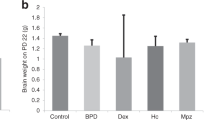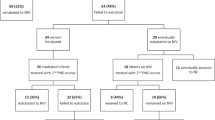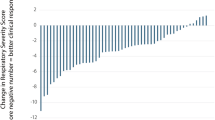Abstract
Neonatal dexamethasone (DEX) for chronic lung disease is associated with adverse outcome. We compared behavioral and motor development at school age of children who neonatally received DEX to children neonatally treated with hydrocortisone (HC) in a retrospective matched cohort study. DEX- and HC-treated groups matched for gestational age, birth weight and year, gender, and severity of respiratory distress syndrome were compared with a reference group (REF) and a group treated only antenatally with betamethasone (BMETH). REF and BMETH groups had a higher gestational age and less severe respiratory distress syndrome. From 192 children (DEX, n = 46; HC, n = 52; REF, n = 43; BMETH, n = 51), the Child Behavioral Checklists from parents and teachers (Teacher's Report Form) and the Movement Assessment Battery for Children to assess neuromotor function were analyzed. DEX girls had a poorer performance on nearly all behavioral scales of the Teacher's Report Form compared with HC girls. DEX boys did not differ from HC boys. The HC boys or girls did not differ from the REF or BMETH groups. Neuromotor development was poorer in DEX than the BMETH and REF groups. The HC group did not differ from REF and BMETH groups. We suggest that neonatal HC may be a “safer” alternative for DEX for the treatment of CLD.
Similar content being viewed by others
Log in or create a free account to read this content
Gain free access to this article, as well as selected content from this journal and more on nature.com
or
Abbreviations
- ABC Movement:
-
Movement Assessment Battery for Children
- BMETH:
-
betamethasone
- CBCL:
-
Child Behavioral Check List
- CLD:
-
chronic lung disease
- DEX:
-
dexamethasone
- GC:
-
glucocorticoid
- HC:
-
hydrocortisone
- REF:
-
reference
- TRF:
-
Teacher Report Form
References
Shinwell ES, Karplus M, Reich D, Weintraub Z, Blazer S, Bader D, Yurman S, Dolfin T, Kogan A, Dollberg S, Arbel E, Goldberg M, Gur I, Naor N, Sirota L, Mogilner S, Zaritsky A, Barak M, Gottfried E 2000 Early postnatal dexamethasone treatment and increased incidence of cerebral palsy. Arch Dis Child Fetal Neonatal Ed 83: F177–F181
Barrington KJ 2001 The adverse neuro-developmental effects of postnatal steroids in the preterm infant: a systematic review of RCTs. BMC Pediatr 1: 1
O'Shea TM, Kothadia JM, Klinepeter KL, Goldstein DJ, Jackson BG, Weaver RG 3rd, Dillard RG 1999 Randomized placebo-controlled trial of a 42-day tapering course of dexamethasone to reduce the duration of ventilator dependency in very low birth weight infants: outcome of study participants at 1-year adjusted age. Pediatrics 104: 15–21
Yeh TF, Lin YJ, Lin HC, Huang CC, Hsieh WS, Lin CH, Tsai CH 2004 Outcomes at school age after postnatal dexamethasone therapy for lung disease of prematurity. N Engl J Med 350: 1304–1313
Committee on Fetus and Newborn 2002 Postnatal corticosteroids to treat or prevent chronic lung disease in preterm infants. Pediatrics 109: 330–338
Shinwell ES, Karplus M, Bader D, Dollberg S, Gur I, Weintraub Z, Arnon S, Gottfreid E, Zaritsky A, Makhoul IR, Reich D, Sirota L, Berger I, Kogan A, Yurman S, Goldberg M, Kohelet D 2003 Neonatologists are using much less dexamethasone. Arch Dis Child Fetal Neonatal Ed 88: F432–F433
Kaempf JW, Campbell B, Sklar RS, Arduza C, Gallegos R, Zabari M, Brown A, McDonald JV 2003 Implementing potentially better practices to improve neonatal outcomes after reducing postnatal dexamethasone use in infants born between 501 and 1250 grams. Pediatrics 111: e534–e541
Halliday HL, Ehrenkranz RA, Doyle LW 2003 Moderately early (7–14 days) postnatal corticosteroids for preventing chronic lung disease in preterm infants. Cochrane Database Syst Rev CD001144.
Doyle LW, Halliday HL, Ehrenkranz RA, Davis PG, Sinclair JC 2005 Impact of postnatal systemic corticosteroids on mortality and cerebral palsy in preterm infants: effect modification by risk for chronic lung disease. Pediatrics 115: 655–661
Watterberg KL, Demers LM, Scott SM, Murphy S 1996 Chorioamnionitis and early lung inflammation in infants in whom bronchopulmonary dysplasia develops. Pediatrics 97: 210–215
Watterberg KL, Gerdes JS, Gifford KL, Lin HM 1999 Prophylaxis against early adrenal insufficiency to prevent chronic lung disease in premature infants. Pediatrics 104: 1258–1263
Thebaud B, Lacaze-Masmonteil T, Watterberg K 2001 Postnatal glucocorticoids in very preterm infants: “the good, the bad, and the ugly”?. Pediatrics 107: 413–415
van der Heide-Jalving M, Kamphuis PJ, van der Laan MJ, Bakker JM, Wiegant VM, Heijnen CJ, Veen S, van Bel F 2003 Short- and long-term effects of neonatal glucocorticoid therapy: is hydrocortisone an alternative to dexamethasone?. Acta Paediatr 92: 827–835
Papile LA, Burstein J, Burstein R, Koffler H 1978 Incidence and evolution of subependymal and intraventricular hemorrhage: a study of infants with birth weights less than 1,500 gm. J Pediatr 92: 529–534
Giedion A, Haefliger H, Dangel P 1973 Acute pulmonary X-ray changes in hyaline membrane disease treated with artificial ventilation and positive end-expiratory pressure (PEP). Pediatr Radiol 1: 145–152
Achenbach TM 1992 Manual for the Child Behavioral Checklist/4-18 and 1991 Profile. University Associates in Psychiatry, Burlington, VT
Van Waelvelde H, De Weerdt W, De Cock P, Smits-Engelsman BC 2004 Aspects of the validity of the Movement Assessment Battery for Children. Hum Mov Sci 23: 49–60
Bakker JM, van Bel F, Heijnen CJ 2001 Neonatal glucocorticoids and the developing brain: short-term treatment with life-long consequences?. Trends Neurosci 24: 649–653
Stark AR, Carlo WA, Tyson JE, Papile LA, Wright LL, Shankaran S, Donovan EF, Oh W, Bauer CR, Saha S, Poole WK, Stoll BJ 2001 Adverse effects of early dexamethasone in extremely-low-birth-weight infants. National Institute of Child Health and Human Development Neonatal Research Network. N Engl J Med 344: 95–101
Haynes RC 1990 Adrenocorticotroph hormone: adrenocortical steroids and their synthetic analogs: inhibitors of the synthesis and actions of adrenocortical hormones. In: Goodman LS, Gilman A, Rall TW (eds) The Pharmacological Basics of Therapeutics. Pergamon Press, New York, pp 1431–1459
Achenbach TM, McConaughy SH, Howell CT 1987 Child/adolescent behavioral and emotional problems: implications of cross-informant correlations for situational specificity. Psychol Bull 101: 213–232
Verhulst FC, Koot HM, van der Ende J 1994 Differential predictive value of parents' and teachers' reports of children's behaviors: a longitudinal study. J Abnorm Child Psychol 22: 531–546
Weitzel HK, Lorenz U, Kipper B 1987 Clinical aspects of antenatal glucocorticoid treatment for prevention of neonatal respiratory distress syndrome. J Perinat Med 15: 441–446
Murphy BP, Inder TE, Huppi PS, Warfield S, Zientara GP, Kikinis R, Jolesz FA, Volpe JJ 2001 Impaired cerebral cortical gray matter growth after treatment with dexamethasone for neonatal chronic lung disease. Pediatrics 107: 217–221
Lodygensky GA, Rademaker K, Zimine S, Gex-Fabry M, Lieftink AF, Lazeyras F, Groenendaal F, de Vries LS, Huppi PS 2005 Structural and functional brain development after hydrocortisone treatment for neonatal chronic lung disease. Pediatrics 116: 1–7
Rademaker KJ, Rijpert M, Uiterwaal CS, Lieftink AF, van Bel F, Grobbee DE, de Vries LS, Groenendaal F 2006 Neonatal hydrocortisone treatment related to 1H-MRS of the hippocampus and short-term memory at school age in preterm born children. Pediatr Res 59: 309–313
Isaacs EB, Lucas A, Chong WK, Wood SJ, Johnson CL, Marshall C, Vargha-Khadem F, Gadian DG 2000 Hippocampal volume and everyday memory in children of very low birth weight. Pediatr Res 47: 713–720
De Kloet ER, Vreugdenhil E, Oitzl MS, Joels M 1998 Brain corticosteroid receptor balance in health and disease. Endocr Rev 19: 269–301
Kamphuis PJ, Gardoni F, Kamal A, Croiset G, Bakker JM, Cattabeni F, Gispen WH, van Bel F, Di Luca M, Wiegant VM 2003 Long-lasting effects of neonatal dexamethasone treatment on spatial learning and hippocampal synaptic plasticity: involvement of the NMDA receptor complex. FASEB J 17: 911–913
Sapolsky RM, Uno H, Rebert CS, Finch CE 1990 Hippocampal damage associated with prolonged glucocorticoid exposure in primates. J Neurosci 10: 2897–2902
National Institutes of Health 1994 Report on the Consensus Development Conference on the Effect of Corticosteroids for Fetal Maturation on Perinatal Outcome. NIH publication no. 95–3784.
Acknowledgements
The authors thank Mrs. Marijke Tersteeg-Kamperman for her invaluable technical assistance and Maike Eussen and Jolanda Hoogeboom for their help with the analysis of the data.
Author information
Authors and Affiliations
Corresponding author
Additional information
Supported by a grant of the Catherijne Stichting, UMC Utrecht, The Netherlands.
Rights and permissions
About this article
Cite this article
Karemaker, R., Heijnen, C., Veen, S. et al. Differences in Behavioral Outcome and Motor Development at School Age After Neonatal Treatment for Chronic Lung Disease with Dexamethasone versus Hydrocortisone. Pediatr Res 60, 745–750 (2006). https://doi.org/10.1203/01.pdr.0000246200.76860.de
Received:
Accepted:
Issue date:
DOI: https://doi.org/10.1203/01.pdr.0000246200.76860.de
This article is cited by
-
Duration of mechanical ventilation is more critical for brain growth than postnatal hydrocortisone in extremely preterm infants
European Journal of Pediatrics (2021)
-
Hydrocortisone and bronchopulmonary dysplasia: variables associated with response in premature infants
Journal of Perinatology (2020)
-
Let’s call the whole thing off: evaluating gender and sex differences in executive function
Neuropsychopharmacology (2019)
-
Safety, Efficacy and Response to a Hydrocortisone Rescue Therapy Protocol in Children with Refractory Hypotension After Cardiopulmonal Bypass
Pediatric Cardiology (2015)
-
Hydrocortisone vs. dexamethasone treatment for bronchopulmonary dysplasia and their effects on general movements in preterm infants
Pediatric Research (2012)



